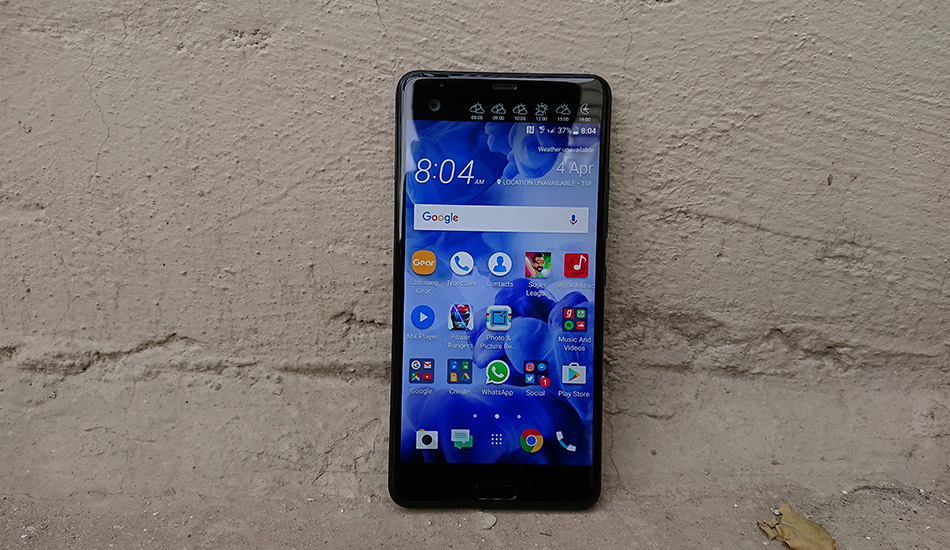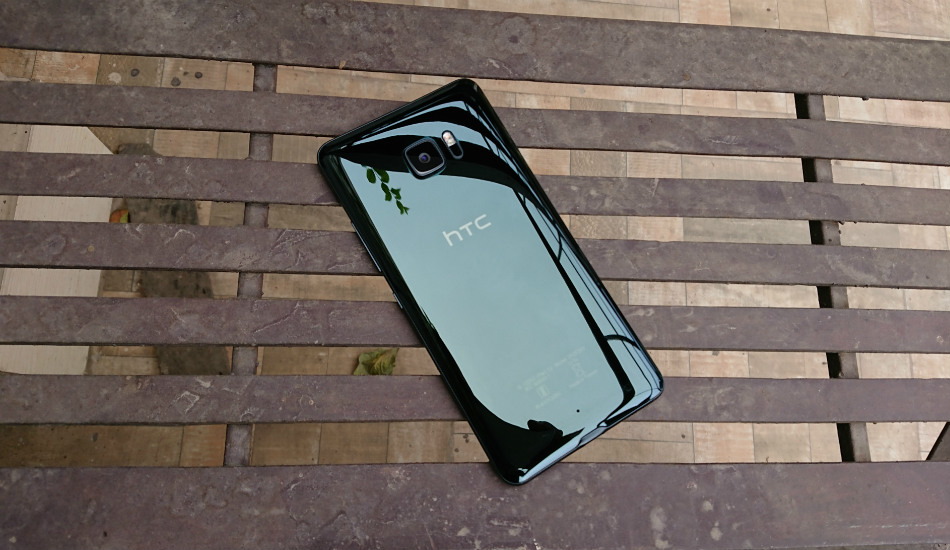HTC is one of those few brands available in the market, which has always tried to deliver something out of the box for its users. The company has been known for contemplating ideas, which were far ahead of its time, but in last few years, we have seen the company losing up against a sizable market share to its competition. But in 2017, the company has opted for a different approach, focusing on the premium segment and abandoning the rest. So, going forward with this philosophy, the brand has introduced two new smartphones, the HTC U Ultra and U Play, pledging that they have something for ‘you’. We have reviewed the smaller sibling in the past, but failed to understand what it has for ‘you’, but it’s time to find out from its elder brother, U Ultra. So, the question is, does it have something for ‘you’ or not? Let’s try and argue.
Design
In this market, where it is a momentous task to differentiate between different devices, HTC has a legacy of giving a distinct look for its smartphones. And this time, the company has skipped the metal body and instead wrapped the device in the glass. The company has also introduced liquid surface, at the rear panel which it claims gives distinct look under different lighting condition. We got the black unit for the review and it was able to show some different shades of grey, but still it is highly reflective in nature and one can easily see who is coming from the back (it got your back, after all). It is also a bit slippery in nature and not to forget, that this thing is a fingerprint magnet. Thankfully, the company has given a transparent case with the box.

But still, it does manage to give the premium look most of us tries to find a device. The body has a smooth finish at the back, and the only bump you feel is at the rear square rear camera hump. The edges are gently curved meeting the thin metal rim that runs around the device. The front is dominated by a large 5.7-inch display coupled with an additional screen at the top with an earpiece, front camera and Sensors at the top, while at the base, you will see a fingerprint scanner which doubles up as a home button flanked by the back and recent menu buttons. To be frank, the navigation controls have a pretty small touch reception area, which sometimes makes it pretty uncomfortable to use them. At the right, there is a power on/off button and volume controls, while the left is bare.
At the top, you will see a SIM slot, while at the base, there is a USB Type-C along with speaker grille. The device is seriously big and it becomes a difficult task to use it one-handedly. But it sleek with 8mm thickness and weighs 170 grammes, which can fit in your jean. Overall, the company did try to give a distinct design for “you”, but it is not seriously meant for people who have small hands (well, big hands doesn’t make a difference either).
Display
Moving on to the display department, the HTC U Ultra packs a large 5.7-inch Quad HD display with a screen resolution of 2560 x 1440 pixels. But the star of the show is the secondary 2.0-inch display infused right at the top of the main screen. The secondary display, is indeed, a smart move by the company as it comes with some handy features. So, for example, one can see the next event, a weather forecast for the rest of the day, different App and contacts shortcuts, control some music apps likes Spotify, Gaana or Google Play Music. But the implementation is pretty buggy in nature. The apps are not optimised to give notifications on such a small screen, which results in cropped notifications. We think that the company could have used the secondary display more effectively.

Moving on, the main display features a Super LCD 5 panel, which gives a pretty decent output. The device has some good viewing angles and the text and icons look sharp enough. The display gives a good output whether be it watching some good animated movies or showing Iron Fist show on Netflix. However, the screen is highly reflective in nature, which sometimes makes it difficult to read and no, the full brightness level doesn’t really help. Coming to the auto brightness, the performance is a bit sluggish in nature and we were not particularly impressed by it. Overall, it does have a good combination of high-res display and a second screen for “you”, but we have seen better displays in other flagships, including the ones in Samsung and Apple.
Performance
So as for the specs are concerned, the HTC U Ultra is powered by a Qualcomm Snapdragon 821 Processor coupled with Adreno 530 GPU. The device is backed by 4GB of RAM and comes in two storage option namely 64GB and 128 GB, with an expandable storage option. The company has chosen a tried-and-tested flagship processor, which lives up to its expectations. The smartphone can handle almost every task you throw at it, whether be it multi-tasking or editing photos and videos on the device.

In the gaming department, the device does not let down either and handles most of the high-end titles like Asphalt 8: Airborne, Dead Trigger 2 and more, without breaking a sweat. However, the thing we were concerned was the overheating. Yes, it does carries some serious overheating issues as the phone temperature rises even if you are listening to music for a long period of time or snapping some photos or recording some videos from the device. If you consider this price point, then this problem seriously needs to be taken care by the company.
Camera
On the camera front, the device sports a 12-megapixel rear camera with 1.55-micron pixels, f/1.8 aperture, hybrid Autofocus which include inbuilt phase detection autofocus and laser autofocus, OIS, dual tone LED flash. For the front, there is a 16-megapixel snapper with f/2.0 aperture, 28mm focal length. The camera specs of the device are pretty impressive, but the performance is rather inconsistent. The rear camera took some good shots in the broad daylight with ample amount of details, though the photos sometimes came out to be a bit oversaturated.

We liked the fact that it supports 4K recording and does a pretty decent job in recording videos, all thanks to the stabilisation. The phone comes with different modes like Pro Mode, Panorama, Zoe Camera, Selfie Panorama, Hyperlapse, Auto HDR etc. The built-in HDR mode does a pretty decent job as well in giving a detailed picture. But when it comes to low lighting situations, the device struggles a bit. The phone is able to handle glares and the pictures are well lit in nature, but the detailing is somewhat not up to the mark. Further, we also get some noises, which were quite prominent in some photos.
Coming to the front-facing camera, it does a pretty decent job while clicking selfies. The photos came out to be well-balanced and decently exposed coupled with some good detailing, however, in low-light graininess was quite visible.
Software
HTC has been known for its smooth user interface and same is reflected in this one. The smartphone runs on the latest Android 7.0 Nougat with company Sense UI running on top of it. Like we said before, the user interface is quite smooth and minimalistic, which has been one of the strongest points for the company. The plus point of the device is it ships with a handful of applications, which is a good move. There are some interesting applications and HTC Boost+ is one of them. Boost+ is resource management app that regularly optimises your smartphone, removes trash to free up some space and it also helps in locking certain apps with a PIN, pattern or fingerprint sensor.

There is also a Theme Engine, which lets you customise your smartphones according to your need. Yes Blinkfeed is still there, which can be accessed by swiping left to right on the home screen that gives you the news feed from various social networks and other portals all at one place
However, coming to the intelligence part, the smartphone major USP (unique selling proposition) of this flagship device is the Sense Companion app. The virtual assistant, as boasted by the company, is meant to offer suggestions like to charge your device or something like this. However, it turned out to be nothing more than an app which you need to download from Play Store. The Companion has an option to show its suggestion on the secondary display or like a bubble in the main display. We have been this device for more than two weeks, just to see how the Sense Companion works and sadly, it hasn’t done much of anything. We have given all the permissions and answered all the opt-in suggestion cards it asked us once or twice in a while and that’s it. There were no suggestions from the app, which the company boasted and yes it is really disappointing. We are hopeful, that soon there might see some activity from Sense Companion.
Battery and Audio
The HTC U Ultra is juiced by 3000 mAh non-removable battery with Quick Charge 3.0. The performance of the battery is above average as it barely makes a day of moderate use which includes, 4G internet, Wi-Fi, calling, chatting, Facebook, checking emails and more. Under heavy usage, you need to plug for charging during after few hours. Thankfully, the quick charge does it magic and juice it up in a short span of time.

HTC has been known for the giving some great performance in the audio department (no one can forget that twin-speaker setup that gave some amazing output). But this time, the company has ditched the 3.5mm Audio Jack in favour of USB-C connector, meaning that you need to shed extra bugs if you want to buy an adapter. But the company has already packed some great headphones which come with a new feature known as HTC USonic. The feature basically analyses your inner ears with a sonar-like pulse to enhance the overall listening experience. Indeed, the function is really handy and the headphones give some exceptional audio output with good noise cancellation and comfortable ear buds.
The device comes still comes with a dual speaker setup, with one at the top, which also acts as an earpiece and one at the base. The performance of the speakers are also good as it delivers some good sound, but in our opinion, it not loud enough as we have seen in other HTC phones.


